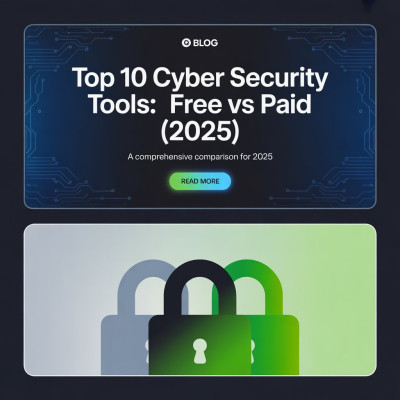
Precious Azuonwu
 best free cyber security tools, cyber security tools 2025
best free cyber security tools, cyber security tools 2025
 0 comment
0 comment
 17 Aug, 2025
17 Aug, 2025

In 2025, cyber threats are more sophisticated than ever. Whether you’re an individual, a small business, or a large enterprise, you need the right tools to safeguard your data, networks, and systems.
But with so many free and paid cyber security tools available, how do you choose?
In this guide, we’ll compare the top 10 tools—covering features, pros, cons, and whether the free or paid option is the best fit for you.
From phishing scams to ransomware, cyberattacks are on the rise. Cyber security tools help detect, prevent, and respond to these threats before damage occurs.
Free tools often offer essential protection but may lack advanced features.
Paid tools usually provide comprehensive coverage, priority support, and enterprise-level scalability.
Security Features and Threat Coverage
Look for tools with real-time monitoring, malware detection, phishing filters, and intrusion prevention systems.
Ease of Use and User Interface
A tool is only as good as your ability to use it—intuitive dashboards save time.
Cost vs Value Analysis
Free may save money upfront, but consider long-term risks and limitations.
Integration with Existing Systems
The best tools work seamlessly with your current software, servers, and workflows.
Tool #1 – Avast Free Antivirus
Best for: Home users
Features: Real-time malware scanning, email protection, ransomware shield.
Tool #2 – Bitdefender Free Edition
Best for: Lightweight, no-fuss protection
Features: Minimal system impact, AI-driven malware detection.
Tool #3 – Snort (Open Source)
Best for: Network intrusion detection
Features: Deep packet inspection, community rule sets.
Tool #4 – Wireshark
Best for: Network analysis and troubleshooting
Features: Detailed traffic monitoring for advanced users.
Tool #5 – Malwarebytes Free
Best for: On-demand malware cleanup
Features: Detects adware, spyware, and PUPs (Potentially Unwanted Programs).
Tool #6 – Norton 360 Deluxe
Best for: All-in-one protection
Features: VPN, password manager, cloud backup, dark web monitoring.
Tool #7 – Kaspersky Premium Security
Best for: Advanced threat detection
Features: Anti-phishing, AI threat prediction, payment protection.
Tool #8 – CrowdStrike Falcon
Best for: Enterprise endpoint security
Features: Cloud-native, AI-driven EDR (Endpoint Detection & Response).
Tool #9 – Trend Micro Maximum Security
Best for: Multi-device households
Features: Web filtering, parental controls, advanced malware blocking.
Tool #10 – Bitdefender GravityZone
Best for: Businesses of all sizes
Features: Centralized management, ransomware mitigation, AI analytics.
Paid tools often score higher in independent lab tests for detecting zero-day threats.
Support and Customer Service Quality
Free tools offer limited or community-based support, while paid options provide 24/7 help.
Scalability for Business or Enterprise Use
Paid tools can manage hundreds of devices with centralized dashboards.
Long-Term Cost Considerations
A single cyberattack can cost thousands—sometimes investing in a paid tool is cheaper than the risk.
Always keep your software up-to-date to protect against new vulnerabilities.
Combining Multiple Tools for Layered Protection
Use both antivirus and firewall tools for better defense.
Training Staff for Optimal Tool Usage
Even the best software fails if users aren’t trained to avoid common mistakes.
AI-Driven Security Solutions
AI is making tools smarter, detecting threats before they strike.
Cloud-Native and Zero Trust Architectures
Security is moving beyond the perimeter—every connection is verified.
Open-Source Innovations in Security Tools
The open-source community continues to produce powerful, cost-effective solutions.
Frequently Asked Questions
Avast Free Antivirus, Bitdefender Free, Snort, Wireshark, and Malwarebytes are top picks.
Yes, especially for businesses or users needing advanced protection and support.
Some can detect ransomware, but paid options often offer stronger, proactive defense.
Bitdefender GravityZone offers robust protection at a reasonable price.
Update at least weekly—daily if possible—to stay ahead of new threats.
Many are reliable, but they require more technical expertise to set up and maintain.
Expect more AI-driven, cloud-based, and zero-trust security frameworks.
Precious Azuonwu
0 comment